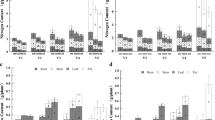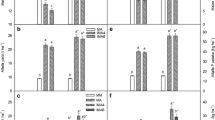Abstract
Aim
This study assessed whether growing cowpea can increase phosphorus (P) availability in the rhizosphere and improve the yield of legume-cereal systems. In alkaline Mediterranean soils with P deficiency, it is assumed that legumes increase inorganic P availability.
Methods
A field experiment was conducted at the Staoueli experimental station, in Algiers province, Algeria, to compare the growth, grain yield, P availability, and P uptake by plants with sole-cropped cowpea (Vigna unguiculata L. cv. Moh Ouali) and maize (Zea mays L. cv. ILT), intercropped cowpea-maize, and fallow.
Results
P availability in the rhizosphere was increased in both sole cropping and intercropping systems compared with fallow. It was highest in intercropping. The increase in P availability was associated with (i) significant pH changes of the rhizosphere of cowpea in sole cropping and intercropping systems, with the rhizosphere acidification significantly higher in intercropping (−0.73 units) than in sole cropping (−0.42 units); (ii) significant increase in the rhizosphere pH of intercropped maize (+0.49 units) compared to fallow; (iii) increased soil respiration (C-CO2 from microbial and root activity) in intercropping compared with sole cropping and fallow; and (iv) higher efficiency in utilization of the rhizobial symbiosis in intercropping than in sole-cropped cowpea.
Conclusion
With cowpea-maize intercropping, cowpea increased the P uptake, by increasing the P availability by rhizosphere pH changes in an alkaline soil. Overall, this study showed that intercropping cowpea improved the plant biomass and grain yield of maize in this soil.








Similar content being viewed by others
References
Alkama N, Bolou Bi Bolou E, Vailhe H, Roger L, Ounane SM, Drevon JJ (2009) Genotypic variability in P use efficiency for symbiotic nitrogen fixation is associated with variation of proton efflux in cowpea rhizosphere. Soil Biol Biochem 41:1814–1823
Alkama N, Ounane G, Drevon JJ (2012) Is genotypic variation of H+ efflux under P deficiency linked with nodulated-root respiration of N2-fixing common-bean (Phaseolus vulgaris L.)? J Plant Physiol 169:1084–1089
Betencourt E, Duputel M, Colomb B, Desclaux D, Hinsinger P (2012) Intercropping promotes the ability of durum wheat and chickpea to increase rhizosphere phosphorus availability in a low P soil. Soil Biol Biochem 46:21–33
Chevallier T, Blanchart E, Albrecht E, Chotte JL, Eschenbrenner V, Voltz M, Mahieu M (1998) Restoration of C content and earth worm population in a vertisol under pasture (Martinique). Presented at the XVIème Congrès Mondial de Science du Sol, Montpellier
Dahmardeh M, Ghanbari A, Syahsar BA, Ramrodi M (2010) The role of intercropping maize (Zea mays L.) and Cowpea (Vigna unguiculata L.) on yield and soil chemical properties. Afr J Agric Res 5(8):631–636
Dawson CJ, Hilton J (2011) Fertiliser availability in a resource-limited world: production and recycling of nitrogen and phosphorus. Food Policy 36:14–22
Depret G, Laguerre G (2008) Plant phenology and genetic variability in root and nodule development strongly influence genetic structuring of Rhizobium leguminosarum biovar viciae populations noduling pea. New Phytol 179:224–235
Devau N, Le Cadre E, Hinsinger P, Gérard F (2010) A mechanistic model for understanding root-induced chemical changes controlling phosphorus availability. Ann Bot 105:1183–1197
Devau N, Le Cadre E, Hinsinger P, Gérard F (2011a) Effects of inorganic fertilization and pH on processes and mechanisms controlling dissolved inorganic phosphorus in soils. Geochim Cosmochim Acta 75:2980–2996
Devau N, Hinsinger P, Le Cadre E, Gérard F (2011b) Root-induced processes controlling phosphate availability in soils with contrasted P-fertilized treatments. Plant Soil 348:203–218
Drevon JJ, Alkama N, Araujo A, Beebe S, Blair MW, Hamza H et al (2011) Nodular diagnosis for ecological engineering of the symbiotic nitrogen fixation with legumes. Proc Environ Sci 9:40–46
Dyson T (1999) World food trends and prospects to 2025. Proc Natl Acad Sci 96:5929–5936
Giller KE, Beare MH, Lavelle P, Izac AMN, Swift MJ (1997) Agricultural intensification, soil biodiversity and agroecosystem function. Appl Soil Ecol 6:3–16
Hinsinger P (2001) Bioavailability of soil inorganic P in the rhizosphere as affected by root-induced chemical changes: a review. Plant Soil 237(2):173–195
Hinsinger P, Plassard C, Tang C, Jaillard B (2003) Origins of root-mediated pH changes in the rhizosphere and their responses to environmental constraints: a review. Plant Soil 248:43–59
Hinsinger P, Betencourt E, Bernard L, Brauman A, Plassard C, Shen J, Tang X, Zhang F (2011) P for two sharing a scarce resource e soil phosphorus acquisition in the rhizosphere of intercropped species. Plant Physiol 156:1078–1086
Ibrahim H, Hatira A, PansuM (2013) Modelling the functional role of microorganisms in the daily exchanges of carbon between atmosphere, plants and soil. Proc Environ Sci 19:96–105
Kouas S, Alkama N, Abdelly C, Drevon JJ (2008) Proton efflux by nodulated roots varies among common-bean genotypes (Phaseolus vulgaris) under phosphorus deficiency. J Plant Nutr Soil Sci 171:242–248
Lambers H, Shane MW, Cramer MD, Pearse S, Veneklaas E (2006) Root structure and functioning for efficient acquisition of phosphorus: matching morphological and physiological traits. Ann Bot 98:693–713
Latati M, Pansu M, Drevon JJ, Ounane SM (2013) Advantage of intercropping maize (Zea mays L.) and common bean (Phaseolus vulgaris L.) on yield and nitrogen uptake in Northeast Algeria. Int J Res Appl Sci 01:1–7, www.knowledgejournals.com/PDF/3.pdf
Li SM, Li L, Zhang F, Tang C (2004) Acid phosphatase role in chickpea-maize intercropping. Ann Bot 94:297–303
Li W, Li L, Sun J, Guo T, Zhang F, Baob X, Peng A, Tang C (2005) Effects of intercropping and nitrogen application on nitrate present in the profile of an OrthicAnthrosol in Northwest China. Agric Ecosyst Environ 105:483–491
Li L, Li SM, Sun JH, Zhou LL, Bao XG, Zhang HG, Zhang FS (2007) Diversity enhances agricultural productivity via rhizosphere phosphorus facilitation on phosphorus-deficient soils. Proc Natl Acad Sci U S A 104:11192–11196
Li H, Shen J, Zhang F, Clairotte M, Drevon JJ, Le Cadre E, Hinsinger P (2008) Dynamics of phosphorus fractions in the rhizosphere of common bean (Phaseolus vulgaris L.) and durum wheat (Triticum turgidum durum L.) grown in monocropping and intercropping systems. Plant Soil 312:139–150
Pan XW, Li WB, Zhang QY, Li YH, Liu MH (2008) Assessment on phosphorus efficiency characteristics of soybean genotypes in phosphorus-deficient soils. Agric Sci China 7:958–969
Schulze J, Drevon JJ (2005) P-deficiency increases the O2 uptake per N2 reduced in alfalfa. J Exp Bot 56:1779–1784
Shen AL, Li XY, Kanamori T, Arao T (1996) Effect of long-term application of compost on some chemical properties of wheat rhizosphere and non-rhizosphere soils. Pedosphere 6:355–363
Tang C, Mclay CDA, Barton L (1997) A comparison of proton excretion of twelve pasture legumes grown in nutrient solution. Aust J Exp Agric 37:563–570
Tang C, Drevon JJ, Jaillard B, Souche G, Hinsinger P (2004) Proton efflux of two genotypes of bean (Phaseolus vulgaris L.) as affected by N nutrition and P deficiency. Plant Soil 260:59–68
Valizadeh GR, Rengel Z, Rate AW (2003) Response of wheat genotypes efficient in P utilization and genotypes responsive to P fertilisation to different P banding depths and watering regimes. Aust J Agric Res 54(1):59–65
White PJ, Broadley MR (2003) Calcium in plants. Ann Bot 92:487–511
Zhang F, Li L (2003) Using competitive and facilitative interactions in intercropping systems enhances crop productivity and nutrient-use efficiency. Plant Soil 248:305–312
Zhang F, Zhang S, Zhang J, Zhang R, Li F (2004) Nitrogen fertilization on uptake of soil inorganic phosphorus fractions in the wheat root zone. Soil Sci Soc Am J 68:1890–1895
Zingore S, Murwira HK, Delve RJ, Giller KE (2008) Variable grain legume yields, responses to phosphorus and rotational effects on maize across soil fertility gradients on African smallholder farms. Nutr Cycle Agroecosyst 80:1–18
Acknowledgments
This work was supported by the Great Federative Project FABATROPIMED of Agropolis Foundation, Montpellier, France, under the reference ID 1001–009 and the joint project AUF-PCSI 59113PS012 and the laboratory of (ENSA) d’Algerie in cooperation with “Institut Technique des Cultures Maraîchères et Industrielles” (ITCMI) in the Staouli region. We would like to thank the “Laboratoire des resources phytogénétiques et des biotechnologies végétales” of ENSA for providing the maize cultivar (ILT).
Author information
Authors and Affiliations
Corresponding author
Additional information
Responsible Editor: Martin Weih..
Rights and permissions
About this article
Cite this article
Latati, M., Blavet, D., Alkama, N. et al. The intercropping cowpea-maize improves soil phosphorus availability and maize yields in an alkaline soil. Plant Soil 385, 181–191 (2014). https://doi.org/10.1007/s11104-014-2214-6
Received:
Accepted:
Published:
Issue Date:
DOI: https://doi.org/10.1007/s11104-014-2214-6




